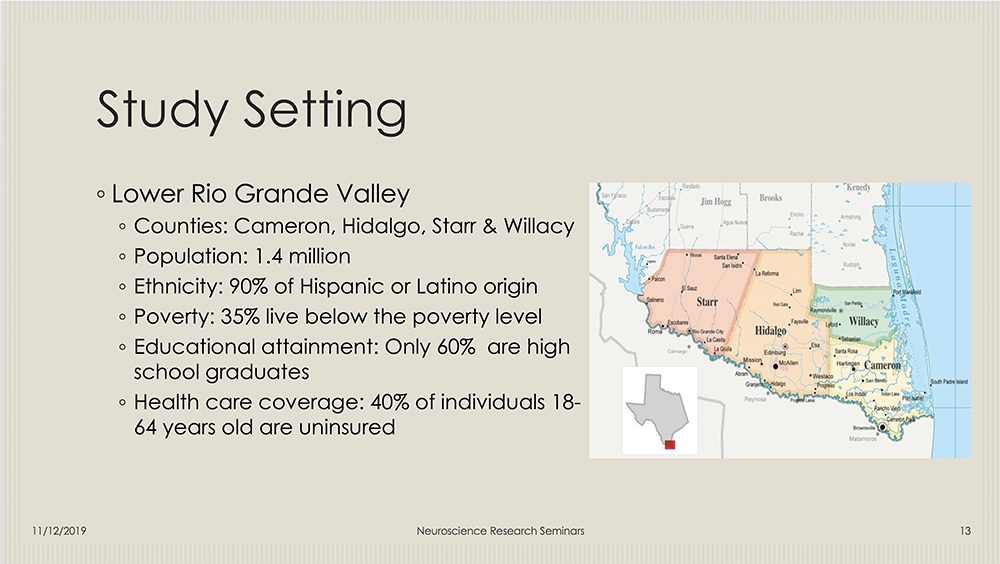
Results from a recent UTRGV survey on mental health disparities show that 14.1% of people in the Rio Grande Valley report moderate depression, which is significantly higher than the national average of 8.1%.
The study’s findings were presented last Tuesday during the Neuroscience Department’s weekly seminar on the Brownsville campus.
Laryssa Mykyta, of the U.S. Census Bureau presented the lecture,“Mental Health Disparities and the Hispanic Mental Health Paradox: Evidence from the Texas-Mexico Border” on behalf of Suad Ghaddar, an assistant professor in the Health and Biomedical Sciences department at UTRGV’s College of Health Professions and one of the study’s collaborators.
Mykyta said the study setting was based on the colonias in the Valley, where most residents live without basic services that are taken for granted in the rest of the United States, such as running water, sewer systems, electricity, paved roads and health facilities.
About 500,000 Texans live in 2,300 colonia communities along the 1,248-mile stretch of the Texas-Mexico border from Cameron to El Paso counties.
Research in this area was done by trained student interviewers at UTRGV who conducted phone surveys. One hundred fifty interviewees completed the survey.
The basis of this study was centered on research questions asking:
–what are the mental health care needs and utilization patterns among residents of the Rio Grande Valley?
–are there differences in mental health outcomes among Hispanics on the Texas-Mexico border by nativity status?
–which factors determine mental health outcomes for U.S.- and foreign-born Hispanics on the Texas-Mexico border?
The study found that 40% of individuals between the ages of 18 and 64 are uninsured, meaning that many people in the Valley have limited access to mental health services. The cause of this limited access are a shortage of mental health professionals and lack of affordability for residents of the region, which are barriers to seeking care.
Surveys asked questions on mental health using instruments, including depression (PHQ-9), anxiety (GAD-7), PTSD and frequency of poor mental health days.
Physical health, chronic diseases, pain and disability were self-rated.
Results also indicate an immigrant advantage in mental health outcomes, according to the study. “However, this advantage is mitigated by duration of residence and structural inequalities,” the study found.
Researchers found that unique stressors in the Valley, such as high levels of material hardship, predict mental health outcomes. With levels of mental health problems at an increase in the area, research found that only one in five of those reporting mental health problems actually saw a counselor.
Many people have a stigma about mental health and tell themselves, “I can handle these emotions on my own,” according to the study.
The solution to breaking the stigma is to push for patient education and outreach to improve mental health literacy, Mykyta said.
“Understanding disparities in mental health in this underserved area can really help target interventions and are especially critical,” she said.
Funding for the research was provided by the Collaborative on Population Health Innovation and Improvement, a two-year UT System initiative to support the development and implementation of strategic plans addressing Texas’ most critical public health needs, according to information provided at the seminar.
Its mission is “to position UTRGV as a national leader in population health innovation through productive community partnerships, educational excellence, and a rigorous research agenda focused on improving population health in the Rio Grande Valley and beyond,” according to the presentation.





